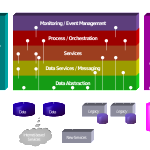Risks in Software Development and How to Mitigate Them
In the rapidly evolving world of technology, software development projects face numerous risks that can derail their progress and compromise outcomes. Understanding and mitigating these risks is crucial for project managers and development teams aiming for success. This article will explore the common pitfalls in software development and provide actionable strategies to mitigate these risks, backed by research findings. Our conversation will revolve around ensuring that your project survives and thrives in the dynamic landscape of technology.
Also Read This: Cloud vs. SaaS Applications: What’s the Key to Your Digital Success?
1. Scope Creep: The Silent Project Killer
Many in the software development world dread the term scope creep. Scope creep refers to the uncontrolled expansion of project scope without time, resources, or budget adjustments. A Project Management Institute (PMI) study highlighted that 52% of projects experienced scope creep, which led to delayed deliveries and budget overruns.
Mitigation Strategy
Rigorous Requirements Analysis: Begin by thoroughly analyzing project requirements. Involve stakeholders in discussions to ensure all needs are captured accurately.
Change Control Process: Implement a structured process for managing changes. Any deviation from the initial scope should go through a review process, considering the impact on resources and deadlines.
2. Technical Debt: Compromising Future Stability
Technical debt refers to the cost of cutting corners in software development. This could mean choosing a quicker, less optimal solution to meet immediate deadlines, which can compromise the stability and scalability of the software in the long run.
Mitigation Strategy:
Prioritize Refactoring: Allocate time in your development cycles for refactoring and addressing technical debt. This will ensure that your codebase remains clean and maintainable.
Code Reviews: Adopt a culture of code reviews. This practice can help identify potential areas of debt early on, allowing for timely improvements.
3. Inadequate Testing: A Gateway to Failure
Refraining from underestimating the importance of testing can lead to software riddled with bugs and vulnerabilities. A Consortium for IT Software Quality (CISQ) report estimates that software errors cost the US economy approximately $2.08 trillion in 2020.
Mitigation Strategy:
Adopt Test-Driven Development (TDD): This approach encourages writing tests before code, ensuring that testing is integrated into the development process.
Automated Testing: Invest in automated testing tools. They can perform repetitive tasks efficiently, allowing your team to focus on complex test scenarios.
4. Poor Project Management: Leading to Chaos
Effective project management is the backbone of any successful software development project. Poor management can lead to miscommunication, missed deadlines, and project failure.
Mitigation Strategy:
Use Agile Methodologies: Agile frameworks like Scrum and Kanban promote flexibility, continuous feedback, and effective communication among team members.
Regular Check-ins: Schedule meetings to discuss progress, challenges, and adjustments needed to stay on track.
5. Security Vulnerabilities: Inviting Unwanted Guests
In today’s digital age, ignoring security can be catastrophic. According to IBM’s 2020 Cost of a Data Breach Report, the average total cost of a data breach is $3.86 million.
Mitigation Strategy:
Security-First Design: Incorporate security measures right from the design phase of your project.
Regular Security Audits: Conduct security audits and vulnerability assessments regularly to identify and rectify potential threats.
6. Communication Breakdown: The Root of Many Problems
Effective communication is essential for any project’s success. Clear communication can lead to understanding, errors, and frustration among team members.
Mitigation Strategy:
Clear Communication Channels: Establish clear communication channels. Tools like Slack, Microsoft Teams, or Jira can facilitate seamless interaction.
Documentation: Maintain comprehensive project documentation, including requirements, design decisions, and changes. This ensures everyone is on the same page.
Conclusion: Steering Clear of the Pitfalls
Software development is fraught with challenges, but the right strategies and a proactive approach can mitigate these risks. Embrace thorough planning, continuous communication, and a commitment to quality at every stage of the development process. Doing so will help you navigate these risks effectively and pave the way for successful, resilient software projects.
Let’s not view these risks as roadblocks but stepping stones towards mastering the art of software development. With the strategies discussed, backed by research and best practices, you’re now better equipped to tackle





![[Infographic] Things of the ‘Internet of Things’](https://alliedc.com/wp-content/uploads/2015/04/IOTSENSORS-150x150.jpg)

![Demo – Tutorial [in-order message processing]](https://alliedc.com/wp-content/uploads/2019/05/3-150x150.png)